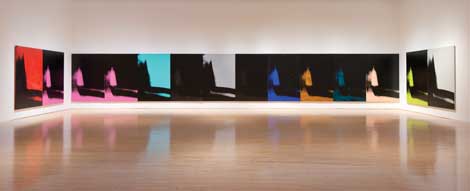It seems the art critics think Andy Warhol’s Shadows painting (1978-79) at MOCA is the worst he has ever done—meaningless disco junk! One has to ask, if it is so terrible why would such a smart artist need 102 canvases to complete the series? Warhol himself called the paintings “disco décor,”which is code for “think what you like, they are too personal for me to talk about.” This is the man who stuck his “fuck you” finger in front of his face every time someone snapped a personal photo of him. My guess is that he didn’t care what critics thought of the work because it was important only to him, not us. The paintings were produced a decade after Valerie Solanas almost killed him, crippling his body and changing his life forever. I think the paintings are about death: Warhol’s own personal death.
It’s not the only time Andy got personal. The silver balloon pillows (silver because it is the color of darkness, the color of moonlight and magic) were released from the roof of the uptown Factory while we all watched. Some whispered he was saying goodbye to The Factory, (we were always very paranoid then). But I thought Andy looked more like Noah releasing birds into the air, expecting a response. The next time we saw the balloon pillows they were stuffed in a gallery on La Cienega Boulevard in Los Angeles, with Warhol insisting that they all hover at the same level. So artist’s ideas don’t escape, they get trapped in a gallery like a herd of sheep and sold for money, and even get mocked by stupid people.
Death is not a stupid idea. It is the one thing we all fear. When you enter MOCA’s gallery, the ominous presence of these paintings surround you. You are the one who can’t escape. They are not just shadows of The Factory, they are shadows in the mind. (There are other shadow “parts”—each of the 102 paintings is referred to as a part, as the Shadows series is actually one painting—besides the ones at MOCA.)
These paintings are about death and they must be repeated because they are never understood. Shadows are the doorway to the underworld, life after death. I feel that through these paintings Andy was trying to come to terms with or explore his own Catholic feelings about death. This painting is not a happy playful experience. You feel surrounded by these black images which you cannot recognize, just as you cannot imagine death. The images are hung low to the ground, animal-like and threatening but not aggressive; rather they are strangely lifeless, as if waiting.
If anyone wanted to paint disco fluff, they wouldn’t need over 102 precisely arranged paintings to do it. But you might need even more to paint the one thing we can’t imagine, the one thing we all fear, and the one thing we cannot escape. Even stars die. But what does it mean to die?
Warhol almost died. The doctors had to massage his heart to pull him back, but the only thing he can tell us about death is fear. There is neither heaven nor hell, just the black shadows waiting relentlessly.
“Andy Warhol: Shadows,” runs through February 2, 2015
at MOCA Grand Avenue, The Museum of Contemporary Art, Los Angeles.
Moca.org


